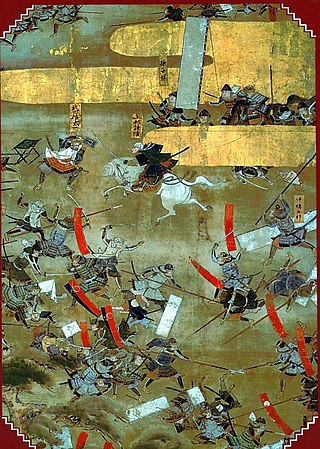
The Sengoku period is the period in Japanese history in which civil wars and social upheavals took place almost continuously in the 15th and 16th centuries. Although the Kyōtoku incident (1454), Ōnin War (1467) or Meiō incident (1493) is generally chosen as the Sengoku period's start date, there are many competing historiographies for its end date, ranging from 1568, the date of Oda Nobunaga's march on Kyoto, to the suppression of the Shimabara Rebellion in 1638, deep into what is traditionally considered the Edo period. Regardless of the dates chosen, the Sengoku period overlaps substantially with the Muromachi period (1336–1573).

Emperor Go-Hanazono was the 102nd emperor of Japan, according to the traditional order of succession. His reign spanned the years from 1428 through 1464.

Ashikaga Yoshihisa was the 9th shōgun of the Ashikaga shogunate who reigned from 1473 to 1489 during the Muromachi period of Japan. Yoshihisa was the son of the eighth shōgun Ashikaga Yoshimasa with his wife Hino Tomiko.

Ashikaga Yoshimasa was the eighth shōgun of the Ashikaga shogunate who reigned from 1449 to 1473 during the Muromachi period of Japan.

Ashikaga Yoshinori was the sixth shōgun of the Ashikaga shogunate who reigned from 1429 to 1441 during the Muromachi period of Japan. Yoshinori was the son of the third shōgun Ashikaga Yoshimitsu. His childhood name was Harutora (春寅). In 1433, he initiated the compilation of the last imperial waka anthology, Shinshoku Kokinwakashū, but was not satisfied with its compilation agenda which undermined his authority.

Kawachi Province was a province of Japan in the eastern part of modern Osaka Prefecture. It originally held the southwestern area that was split off into Izumi Province. It was also known as Kashū (河州).

The Ōnin War, also known as the Upheaval of Ōnin and Ōnin-Bunmei war, was a civil war that lasted from 1467 to 1477, during the Muromachi period in Japan. Ōnin refers to the Japanese era during which the war started; the war ended during the Bunmei era. A dispute between a high official, Hosokawa Katsumoto, and a regional lord, Yamana Sōzen, escalated into a nationwide civil war involving the Ashikaga shogunate and a number of daimyō in many regions of Japan.

Ginkaku-ji, officially named Jishō-ji, is a Zen temple in the Sakyo ward of Kyoto, Japan. It is one of the constructions that represent the Higashiyama Culture of the Muromachi period.

Meiō (明応), also known as Mei-ō, was a Japanese era name after Entoku and before Bunki. This period spanned the years from July 1492 through February 1501. Reigning emperors were Go-Tsuchimikado-tennō (後土御門天皇) and Go-Kashiwabara-tennō (後柏原天皇).

Entoku (延徳) was a Japanese era name after Chōkyō and before Meiō. This period spanned the years from August 1489 through July 1492. The reigning emperor was Go-Tsuchimikado-tennō (後土御門天皇).

Bunmei was a Japanese era name after Ōnin and before Chōkyō. This period spanned from April 1469 through July 1487. The reigning emperor was Go-Tsuchimikado-tennō (後土御門天皇).

Bunshō (文正) was a Japanese era name after Kanshō and before Ōnin. The period spanned the years February 1466 through March 1467. The reigning emperor during this period was Go-Tsuchimikado-tennō (後土御門天皇).

Kanshō (寛正) was a Japanese era name after Chōroku and before Bunshō. This period spanned from December 1460 through February 1466. The reigning emperors were Go-Hanazono-tennō (後花園天皇) and Go-Tsuchimikado-tennō (後土御門天皇).

Kyōtoku (享徳) was a Japanese era name (後花園天皇) after Hōtoku and before Kōshō. This period spanned the years from July 1452 through July 1455. The reigning emperor was Go-Hanazono-Tennō (後花園天皇).

Bun'an (文安) was a Japanese era name after Kakitsu and before Hotoku. This period spanned the years from February 1444 through July 1449. The reigning emperor was Go-Hanazono-tennō (後花園天皇).

Hatakeyama Yoshinari was a Japanese samurai and feudal lord (daimyō) of the Muromachi period, who is most known for his rivalry with Hatakeyama Masanaga over the position of Kanrei, or Shōgun's Deputy.

The Higashiyama culture is a segment of Japanese culture that includes innovations in architecture, the visual arts and theatre during the late Muromachi period. It originated and was promoted in the 15th century by the shōgun Ashikaga Yoshimasa, after he retired to his villa in the eastern hills of capital city Kyoto.
Ichijō Kaneyoshi, also known as Ichijō Kanera, was the son of regent Tsunetsugu. He was a kugyō or Japanese court noble of the Muromachi period (1336–1573). He held regent positions sesshō in 1432, and kampaku from 1447 to 1453 and from 1467 to 1470. Norifusa and Fuyuyoshi were his sons. One of his daughters, Keishi (経子), married Takatsukasa Masahira.
Hino Tomiko was a prominent figure during the Muromachi period and the beginning of the Sengoku period. She was daughter to Hino Shigemasa and was the official wife of Ashikaga Yoshimasa, the eighth shōgun of the Ashikaga shogunate, and the mother of Ashikaga Yoshihisa, the ninth shōgun. Her efforts during the succession dispute are seen as one of the causes of the Ōnin War and led to the beginning of the Sengoku period.
The Kanshō famine, was a famine which affected mostly western Japan from 1459 to 1461, during the reign of Emperor Go-Hanazono in the Muromachi period. The ruling shōgun during the famine was Ashikaga Yoshimasa. The number of deaths from starvation was at least 82,000.











